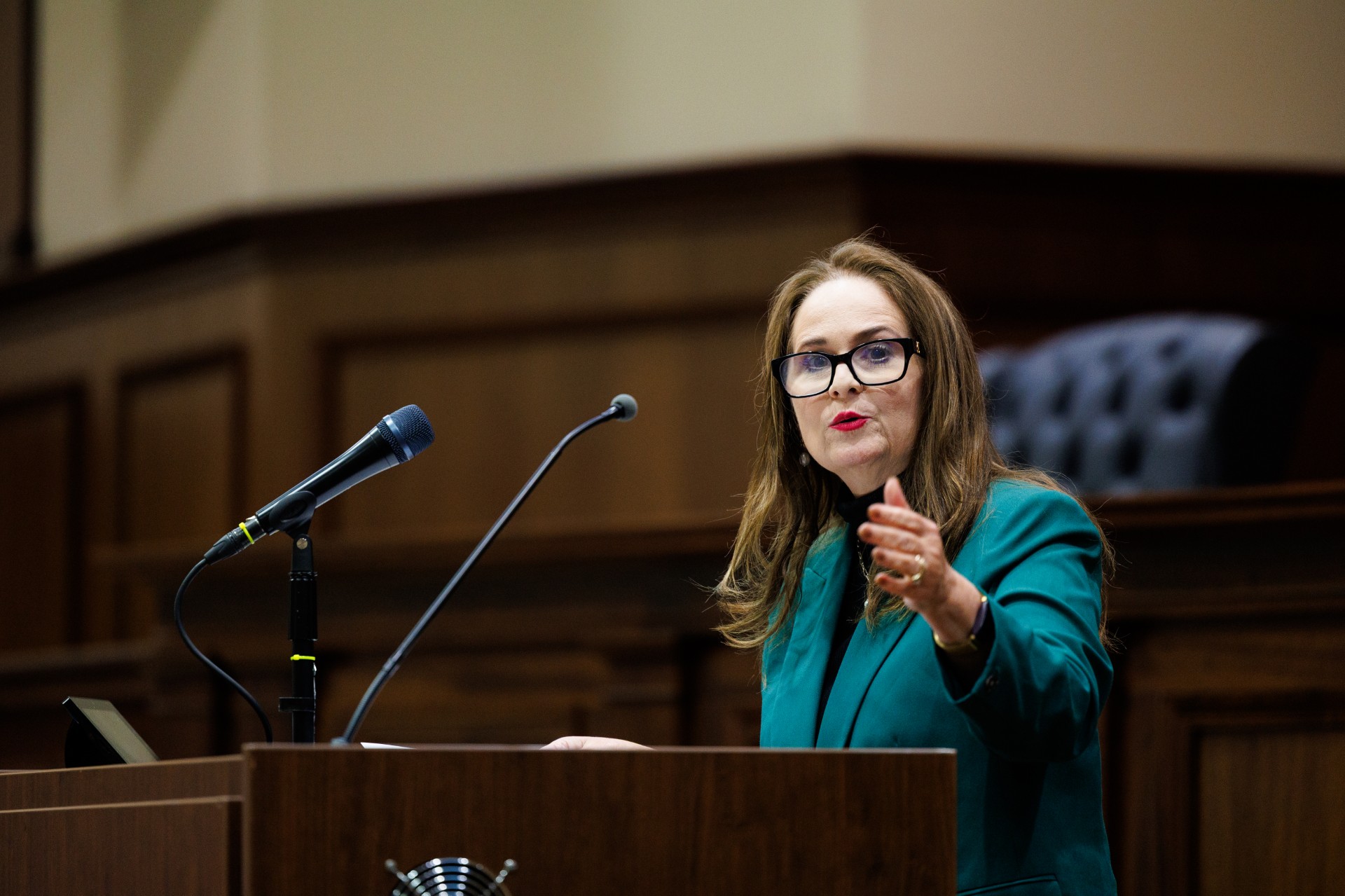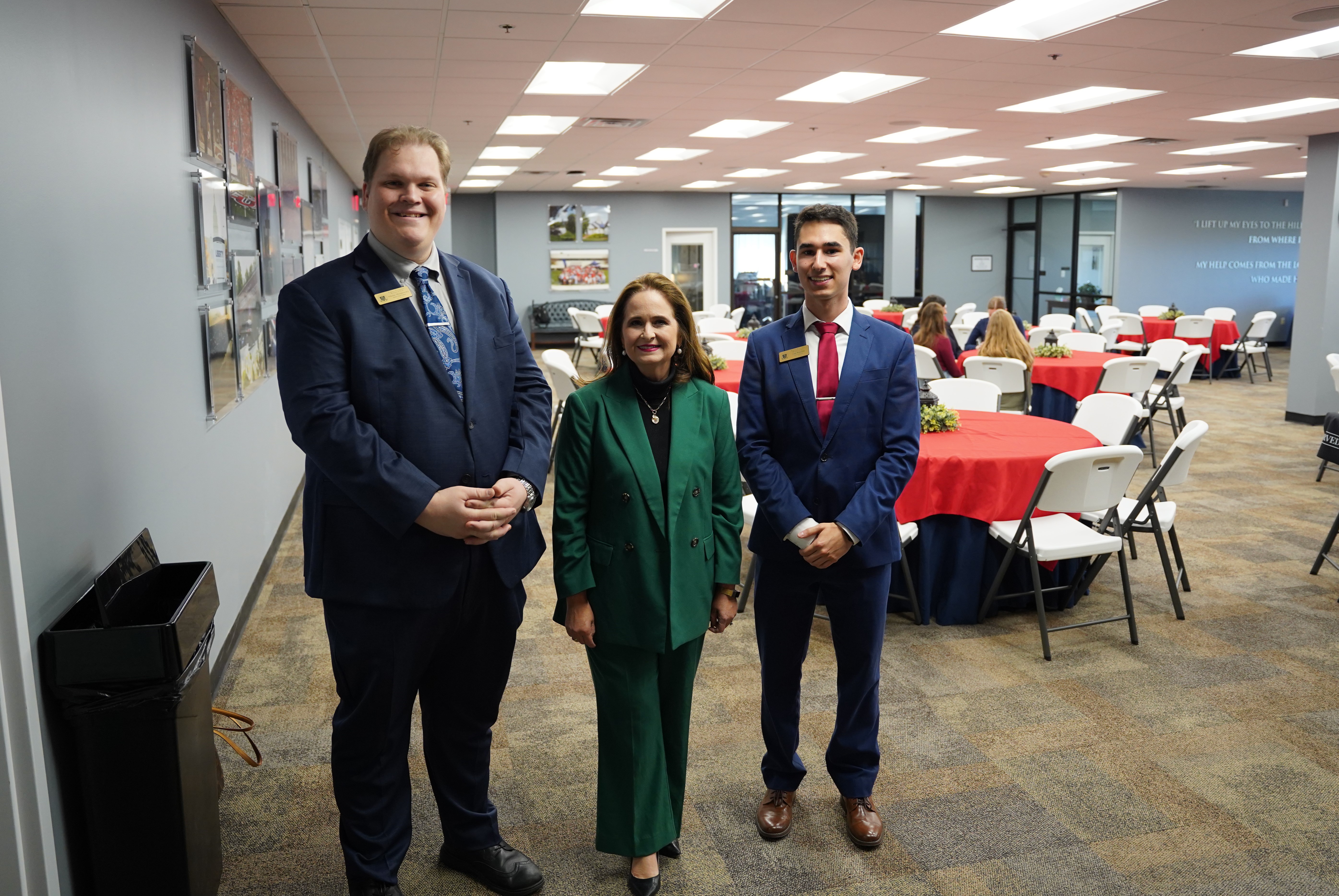Loper Bright Special Issue & Event

Opening Remarks by Professor Eric Bolinder:
Professor Eric Bolinder, Assistant Professor of Law at Liberty University School of Law and faculty advisor of the Liberty University Law Review, opened the Loper Bright Symposium by outlining Liberty Law’s two aims: to “grow our students’ relationships with Jesus Christ” and “train our students to be excellent lawyers.” Professor Bolinder then delivered an overview of Chevron U.S.A. Inc. v. National Resource Defense Council, Inc., and Loper Bright Enterprises v. Raimondo.
He started with the U.S. Supreme Court’s 1984 decision in Chevron. Professor Bolinder explained Chevron’s “two-step” framework. First, if Congress directly and unambiguously spoke on the issue, then that settled the matter. Second, if the statute was silent or ambiguous with respect to the issue, then the Court deferred to the agency’s statutory interpretation if its construction was reasonable.
In Professor Bolinder’s view, “what seemed simple was anything but.” He made the point that even the meaning of the word “ambiguous” could be ambiguous. As Professor Bolinder noted, Chief Justice Roberts characterized this conundrum as a “dizzying breakdance.”
But Loper Bright changed all of that. As Professor Bolinder pointed out, and in the words of Chief Judge Elrod’s opinion in Mayfield v. Department of Labor, Loper Bright was an “unremarkable yet elemental proposition . . . .” Professor Bolinder highlighted Loper Bright’s impact by comparing the 1,400 citations that it has received in judicial opinions in one year with the 700 times that Dobbs v. Jackson Women’s Health Organization has been cited in two years, and the 1,200 times that National Federation of Indepedent Business v. Sebelius has been cited in twelve years.
After establishing Loper Bright’s factual and legal background, Professor Bolinder highlighted the “real faces of this case.” He emphasized that Loper Bright is about “real people with real livelihoods on the line.” “For every decision that a bureaucrat makes in Washington, D.C., there’s a family in New Hampshire, Rhode Island, or New Jersey sitting across the dinner table wondering how they will survive this regulatory cost.” Professor Bolinder underscored the gravity of these bureaucratic decisions because bureaucrats cannot be voted out of office. He rhetorically asked, “Where is [their] day in court?” Professor Bolinder cautioned the audience of future lawyers, judges, and policymakers to not “forget what’s at the core of these cases—real people with real disputes where the outcome might change the trajectory of their lives.”

Chief Judge Jennifer Walker Elrod’s Keynote Address:
After taking the podium, the Honorable Chief Judge Jennifer Walker Elrod of the U.S. Court of Appeals for the Fifth Circuit exclaimed, “This is an exciting place to be!” She said that students bring fresh ideas and new challenges to this area of the law, and in a lighthearted moment, she commented, “I bet you never thought that you would say this is an exciting time to be in administrative law.”
Pivoting to Loper Bright’s legal impact, Chief Judge Elrod observed that the landscape in this space is shifting in a direction that is hopefully more aligned with the Constitution. To prove her point, she pointed to several cases since Loper Bright, such as Corner Post, Inc. v. Board of Governors of the Federal Reserve System, which held that litigants may challenge agency action when they suffer harm rather than when the regulation is promulgated. In another humorous moment, Chief Judge Elrod commented, “No word yet on whether [Corner Post] has opened the floodgates of litigation as the dissenters in that opinion warned.” She also highlighted SEC v. Jarkesy, which affirmed the constitutional right to a jury trial when agencies bring certain enforcement actions.
Chief Judge Elrod said, “These are important cases that will shape the new era in administrative law.” She reasoned that these cases are “back in line with our Constitution’s separation of powers design.” She cautioned, however, that “Loper Bright did not say that Congress could not empower agencies to exercise discretion in some respects.”
Chief Judge Elrod then artfully reviewed the frustrating split in judicial perspectives on the Chevron doctrine before Loper Bright. During Chevron’s rule, the Chief Judge expressed that she was bound by Chevron despite fractured perspectives among judges. As an example, she recalled a typical Chevron case in which her colleague argued that the Fifth Circuit need not apply Chevron—characterizing the doctrine as “Lord Voldemort.” But Chief Judge Elrod applied Chevron because it was still binding law, and she sees her position in the federal judiciary as “middle management.”
In a footnote to her majority opinion in that case, Chief Judge Elrod noted that Chevron (the precedent that “need not be named”) was still in effect. She noted that her majority opinion quoted Harry Potter to emphasize the point: “Fear of the name increases fear of the thing itself.” She said the Harry Potter reference seemed appropriate. Not only has Chief Judge Elrod quoted Harry Potter, but she has also quoted Coco Chanel, The Hitchhiker’s Guide to the Galaxy, and The Princess Bride in other opinions.
In an insightful reflection, Chief Judge Elrod said that “the post-Chevron administrative law landscape that Loper ushered in is the norm, and Chevron’s scheme is the exception.” She continued that the correct framework post-Chevron is for courts to judicially review questions of law de novo and defer to an agency’s findings of fact. Congress can craft statutes that give agencies discretion to make specific determinations, like who is an employee under the National Labor Relations Act. Chief Judge Elrod highlighted that agencies still play an important role in establishing the record and filling in the gaps of a statutory scheme.

She repeated that, “properly understood, it was Chevron that departed with the longstanding relationship between agencies and courts, and Loper Bright returned us to the proper constitutional balance.” “Under Loper Bright, the playing field between agencies and private powers is more level.” But “Loper did not say that Congress cannot ever give agencies discretion. It must be a deliberate statutory empowerment or by carefully prescribing rules so that agencies can fill up the details.”
The Chief Judge commented that the major questions doctrine is still in a “formative stage.” She said that some people view the doctrine as a bar on delegation, and others view it as a linguistic tool because it is unlikely that Congress meant to delegate such a vast amount of political and economic power. She recognized that Skidmore deference may not survive after Loper Bright, but it is uncertain due to the “tension” between Loper Bright’s command to find the statute’s correct meaning and Skidmore’s persuasive force in agency decisions.
In her final thoughts, Chief Judge Elrod remarked that there is a “lot percolating in this area.” “Loper Bright ushered back an era where courts in the administrative law context return to doing what courts do—interpreting questions of law.” “Nothing in Loper forecloses Congress from delegating certain powers and decisions to agencies when they do so explicitly and within constitutional bounds.”
“We are more in line with traditional concepts of separation of powers, which our Founders would be well-pleased with.”

Panel 1: Agencies & Judicial Review
The first afternoon panel discussion was moderated by Professor Carl Benoit, associate professor of law at Liberty University School of Law, with panelists William Burner, Will Yeatman, and Marc Wheat. The panel discussed the legal landscape following Loper Bright. Each panelist summarized their own scholarship on the matter.
Mr. William Burner is a law clerk for the Northern District of West Virginia and adjunct professor at Liberty University School of Law. Mr. Burner emphasized that, following Loper Bright, courts can still be informed by an agency’s expertise without being compelled to defer to the agency’s interpretation. Mr. Burner highlighted the concept of “considering without conceding,” where the expertise of administrative agencies is still important to inform a court’s analysis, but that expertise is not equivalent to authority. As he put it, “courts should not yield their interpretation of the law to these experts.” Mr. Burner used the analogy of a triangle to demonstrate the separation of powers among the branches of government. He noted that Chevron deferred legal interpretation to administrative agencies, merged the powers of the executive with the powers of the judiciary, and thus “flatten[ed] the triangle.” Loper Bright, Mr. Burner remarked, restored the proper triangle, which embodies the constitutional separation of powers.
Mr. Will Yeatman is a senior legal fellow at Pacific Legal Foundation as well as a researcher at the Cato Institute. Mr. Yeatman spoke on the Department of Justice’s traditional litigation strategy during the era of Chevron deference and the shift in its strategy following Loper Bright. Finally, Mr. Yeatman highlighted the shift in legal outcomes due to Loper Bright. Before Loper Bright, the government prevailed in the vast majority of lawsuits that involved administrative law. However, following Loper Bright, the government is now losing more than half of its cases. Mr. Yeatman emphasized that these statistics highlight the “earth-shattering impact” of Loper Bright.
The next panelist was Mr. Marc Wheat, general counsel for Advancing American Freedom. Mr. Wheat focused on the interaction between Chevron deference and the abortifacient drug, Mifepristone. Mr. Wheat explained how the U.S Food and Drug Administration (FDA) erroneously authorized Mifepristone based on its own interpretation of a statutory provision that allowed the FDA to approve drugs for serious or life-threatening illnesses. Because of Chevron deference, the FDA could authorize Mifepristone based on its own opinion that pregnancy is a “serious or life-threatening illness.”
Professor Benoit asked the panel what work is left following Loper Bright in order to restore the traditional constitutional order of separation of powers within the three branches of government. Mr. Wheat believed it would take a lifetime of work to undo the damage of Chevron’s development of the administrative state. He stated that the legal system must look to traditional models of constitutional jurisprudence to determine “who decides.” Mr. Yeatman answered that this work can be accomplished through the diligent work of lawyers and law students in public interest organizations. Mr. Burner responded that the administrative state cannot be flipped like a light switch. As such, it will take time and dedication to undo the totality of Chevron’s effects.
A question-and-answer session followed. One attendant asked the panel about the role of state legislatures and state political involvement in continuing the work toward a constitutional rebalance of power following Loper Bright. Mr. Yeatman responded that although Loper Bright is only binding on federal courts, many states have engaged in a similar Chevron deference analysis. Similar to the federal courts, the trend in the states points away from agency deference. Thus, issues of deference are a ripe area for debate at the state level. Mr. Wheat encouraged the audience to get involved with attorney generals’ offices on the state level.

Panel 2: The Legal Landscape Following Loper Bright
The second afternoon panel discussion was moderated by Professor Eric Bolinder, Assistant Professor of Law at Liberty University School of Law, with panelists John Vecchione, Michael Pepson, and Ryan Bangert. At the core of the second panel was a hopeful answer to a daunting question: How does the legal world react to those who are vested with authority to interpret the law?
John Vecchione, senior litigation counsel at New Civil Liberties Alliance, opened by noting that Chevron, which was a doctrine that was originally crafted and supported by conservative jurists, became something reviled by the same conservative jurists. The answer to the seeming paradox was rooted in what those with authority (judges) were doing with that authority when Chevron was decided. Mr. Vecchione stated that his administrative law professor—the late Judge Barry Silverman of the U.S. Court of Appeals for the Ninth Circuit—“was very pro-Chevron, and the reason he was pro-Chevron was because he had seen judges during the 70’s and early 80’s . . . interpreting statutes in such a way that was just what they liked.” Mr. Vecchione went on to describe how Judge Silverman:
felt that the President at least was elected, and that if the President’s administration [was] allowed to go its own way on those regulations, then the American people would have some say in what these [regulations] were, and it wouldn’t be unelected judges approving things they liked and didn’t like.
Chevron, then, could be construed originally as a conservative response to what might be described as “judicial activism.” Clearly, however, the conservative position changed.
Ryan Bangert, senior vice president at Alliance Defending Freedom, highlighted this transition through Justice Scalia’s position. Justice Scalia was a champion of Chevron at its outset but “had the humility to begin moving away from Chevron.” Indeed, Mr. Bangert noted that less than a year before Justice Scalia passed, he expressed this transition in his concurring opinion in Perez v. Mortage Bankers Association. The change in the conservative jurists’ allegiances flowed from their recognition that “the courts had handed so much power to the administrative state to engage in what is fundamentally Article III; judging [and] interpreting the law had created an imbalance of power [and] disrupted our separation of powers.”
Michael Pepson, regulatory counsel at Americans for Prosperity Foundation, noted that as much as Loper Bright was rooted in the Administrative Procedure Act, the majority opinion had “a constitutional flavor when it[] [was] talking about Marbury v. Madison . . . when it’s talking about the role of the judiciary” and further noted that “Justice Thomas’s concurrence flat out sa[id] that [Chevron] deference would violate Article III.”
The prognosis at first glance seems bleak. Activist judges were replaced with an unchecked administrative state. What possible good could come of returning that power to the judiciary? Doesn’t that simply empower the same activists on the bench as in the days before Chevron? But the panelists agreed that the “converging trends of originalism” will preserve the Constitution’s boundaries and separation of powers.


